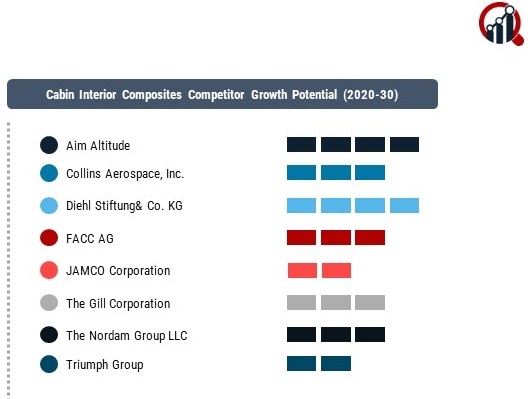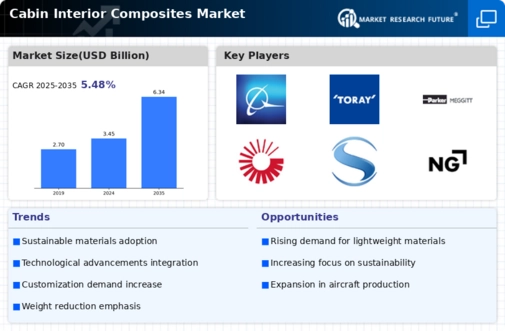Top Industry Leaders in the Cabin Interior Composites Market

Competitive Landscape of Market
Aim Altitude (UK)
Collins Aerospace, Inc. (US)
Diehl Stiftung& Co. KG (Germany)
FACC AG (Austria)
JAMCO Corporation (Japan)
The Gill Corporation (US)
The Nordam Group LLC (US)
Triumph Group (US)
Safran (France)
and BASF Corporation (Germany)
Strategies Adopted
Current investment trends in the Cabin Interior Composites industry underscore a focus on research and development, manufacturing capabilities, and sustainability initiatives. Key players are directing investments towards developing next-generation composite materials, optimizing production processes, and reducing environmental footprint throughout the product lifecycle. Investments in advanced manufacturing technologies such as automated lay-up systems, additive manufacturing, and digital twin simulations are prevalent, reflecting the industry's commitment to improving efficiency and quality control. Additionally, strategic investments in material testing facilities, regulatory compliance, and supply chain resilience aim to ensure product reliability and customer satisfaction.
Emerging Companies
As the aerospace industry continues to embrace composite materials for cabin interiors, new and emerging companies are entering the market, contributing to innovation and product development. Start-ups and specialized firms such as EconCore NV, TenCate Advanced Composites, and Diehl Aerospace GmbH are gaining recognition by providing novel composite solutions tailored to specific cabin interior applications. These companies leverage expertise in material science, manufacturing processes, and design engineering to produce lightweight, customizable, and environmentally sustainable composite panels and structures. The industry is witnessing a trend towards the development of composite materials with enhanced fire-retardant properties, acoustic insulation, and resistance to wear and tear, meeting the evolving safety and comfort requirements of passengers and crew members.
Industry news within the Cabin Interior Composites market reflects ongoing trends, regulatory changes, and technological advancements driving the sector forward. News related to the certification of new composite materials, collaborations between material suppliers and aircraft manufacturers, and advancements in composite manufacturing techniques showcase efforts to enhance cabin interior performance, aesthetics, and sustainability. Moreover, developments in recyclable and bio-based composite materials, as well as innovations in composite joining and assembly technologies, are frequently covered in industry news, highlighting the industry's commitment to environmental stewardship and operational efficiency.
The overall competitive scenario in the Cabin Interior Composites market is characterized by established material suppliers and innovative newcomers, each navigating the industry with distinct strategies. Market share analysis considers factors such as material performance, cost-effectiveness, and customer support. The industry's responsiveness to technological advancements, regulatory requirements, and customer preferences further shapes competitiveness. As the demand for lightweight, durable, and sustainable cabin interior solutions continues to grow, companies in this sector are striving to balance innovation, reliability, and affordability to maintain a competitive edge in a dynamic and highly specialized market.
Recent News
Hexcel (France):
Focus on Sustainable Composites: Hexcel actively develops lightweight and fire-resistant composites made from recycled materials, promoting both sustainability and performance in aircraft interiors.
Partnership with Airbus: Hexcel collaborates with Airbus on the development of next-generation composite materials for cabin interiors, offering increased design flexibility and weight reduction.
AeroContro Aerospace (USA):
Emphasis on 3D Printed Cabin Components: AeroContro pioneers 3D printing technology for producing complex and customized cabin interior parts, enabling faster production and design freedom.
Focus on Lightweight and Recyclable Materials: AeroContro prioritizes using lightweight and recyclable materials in their 3D printed components, contributing to both fuel efficiency and sustainability.
Boeing (USA):
Investment in Advanced Composite Manufacturing: Boeing invests heavily in advanced composite manufacturing techniques, such as automated fiber placement, for more efficient and cost-effective production of cabin interior components.
Focus on Passenger Comfort and Wellbeing: Boeing incorporates innovative materials and design elements in their cabin interiors, emphasizing passenger comfort, noise reduction, and overall wellbeing.
Collins Aerospace (USA):
Emphasis on Modular and Customizable Interiors: Collins Aerospace offers modular and customizable cabin interior solutions, allowing airlines to tailor their cabins to specific needs and passenger preferences.
Focus on In-Flight Entertainment and Connectivity: Collins Aerospace integrates advanced in-flight entertainment systems and seamless connectivity solutions into their cabin interiors, enhancing passenger experience.
Safran Cabin (France):
Focus on Premium Cabin Design and Innovation: Safran Cabin specializes in designing and manufacturing premium cabin interiors for airlines, offering luxurious and innovative features.
Emphasis on Lightweight and Aesthetic Materials: Safran Cabin prioritizes using lightweight and aesthetically pleasing materials in their premium cabin designs, balancing style with functionality.
Emerging Trends in Cabin Interior Composites Companies:
Increased adoption of sustainable and recyclable materials in composite production.
Advancement in 3D printing technology for customized and complex cabin components.
Focus on passenger comfort and wellbeing through innovative materials and design elements.
Emphasis on modularity and customization to cater to diverse airline needs.
Integration of advanced in-flight entertainment and connectivity solutions for an enhanced passenger experience.


